skip to main |
skip to sidebar
The Festival
The first Shackerstone Family Festival was held in 1995, organised by members of the Ashby Canal Association, the Shackerstone Railway Society and Shackerstone Village, to raise money for national and local charities. It has been held each year since, raising all told an estimated 500,000 pounds for charity.
In 2007, my friend Keith was visiting from Australia when that year's Shackerstone Family Festival was held. Keith, John Archer and I attended as visitors on Sunday, 2nd September 2007, as described briefly here with a link to pictures of the various activities.
The 20th Anniversary Show was held on the 6th and 7th September 2014 and around 15,000 visitors were expected over the two days. In 2014, attractions in the Arena Field included Robin Hood and the Sheriff of Nottingham, Sheep Racing, Duck Herding, Tractor Pulling, a Wild West Show, Lawn Mower Grand Prix, Canine Obedience and Agility Demonstrations, Classic Car, Commercial and Vintage Bike Rally, Traction Engines, Traditional Children's Fun Fair and Ferris Wheel, Miniature Train Rides, a Beer Festival, Phase One Steel Band and Snibston Co-op Band. On the Ashby Canal, there was the usual Rally of Boats with Trips offered along the canal. In the air, there was a Spitfire display and an aerobatic display. And, of course, steam train rides from Shackerstone to Shenton. There's a short video of the 2014 event here.
The Battlefield Line and the Festival
The railway operated by Shackerstone Railway Society forms an important attraction for the Festival and I've been rostered as driver for a number of Festivals in previous years but I don't think they're described in this blog, apart from 2012 on when I was steam driver on the second day of that year's Festival. There's a rather incomplete report in the post A Busy Few Days
In 2014, I was rostered as the driver of '3803' on Sunday, 7th September 2014, with Steve. I didn't see much of the other attractions, apart from part of the Spitfire display and part of the aerobatic display by the Aerostars Aerobatic Display Team.
Preparation of 3803
The effectiveness of the firebox of a steam locomotive depends upon the condition of the firegrate. Like a domestic coal grate, the firegrate is usually cast iron provided with air spaces so that combustion air can pass upwards through the burning fuel and the incombustible remains of the coal, the ash, can drop downwards so as not to 'choke' the fire. In a locomotive this is normally achieved by having a series of specially-shaped cast bars called 'firebars' laid parallel in a rack with protrusions so as to leave air spaces between the bars. The life of a firebar is variable because they are operating in a hostile environment and 12 replacement firebars were available which Adrian fitted before we lit the new fire. This involved actually climbing inside the firebox (still warm from the previous day's running), wrestling out the rather mangled remains of the firebars to be replaced and slotting-in the new firebars. I never liked entering a warm firebox and I wouldn't attempt it now at my advanced age. But, thanks to Adrian, we now had a good-looking grate and the fireman, Steve, lit the fire with confidence. As expected, '3803' steamed well all day.
 Adrian fitting the new firebars in the firebox, still hot from the previous day's steaming
Adrian fitting the new firebars in the firebox, still hot from the previous day's steaming
I busied myself oiling round and doing the daily exam. I found one cork missing and Adrian found a replacement. Great Western engines are rugged. The two big cylinders (each 18.5 x 30 inches) develop a tractive effort at the railhead of 35,380 pounds - all transmitted through the two crankpins of the driving axle by the big ends of the connecting rods, so it's not surprising that generous bearing areas are provided on those crankpins.
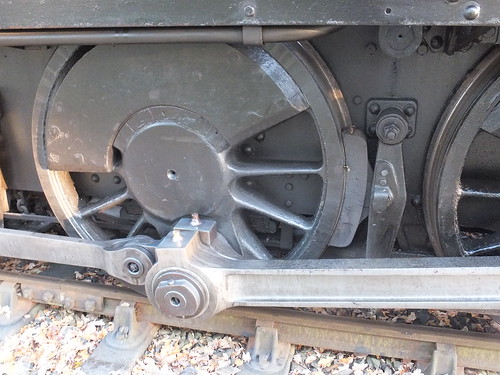 Right hand driving wheel and big end of connecting rod.
Right hand driving wheel and big end of connecting rod.
In Traffic
The Aveling Barford locomotive 'Blue Circle' was scheduled to be giving brake van rides during the day, so we had to wait for her to get steam up and shunt out of the way before we could come 'off-shed'. On the previous evening, there had been a 'Special' for the Exhibitors at the Festival so we found our 5-coach train was, unusually, stabled in Platform 1. In plenty of time, we gently shunted onto our train and coupled up.
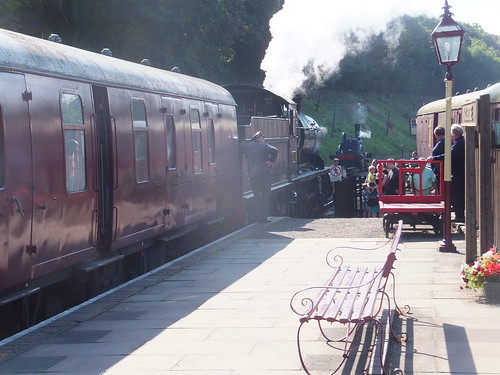 3803 ready to take the first departure from Shackerstone out of platform 1, with 'Blue Circle' in the background.
3803 ready to take the first departure from Shackerstone out of platform 1, with 'Blue Circle' in the background.
The weather was glorious and there were plenty of passengers so our first trip down the line to Shenton was very enjoyable as, indeed were all our trips. By the time we got back to Shackerstone, 'Blue Circle' had attached a brake van and was giving passenger rides on platform 1, so we were routed into platform 2. 'Blue Circle had to 'hide' up the Railcar Siding each time we used platform 1 to run-round our train.
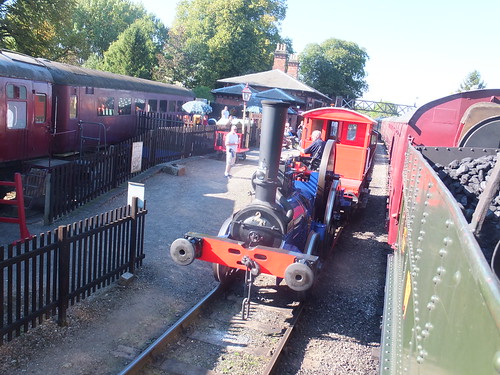 '3803' ready to depart for Shenton as 'Blue Circle' resumes brake van rides.
'3803' ready to depart for Shenton as 'Blue Circle' resumes brake van rides.
For a number of years, public access problems at Market Bosworth meant that passenger trains could not stop there. That's now resolved: access from the main road out of Market Bosworth is via the Station Drive where we have a large car park. There's then a foot crossing to reach the single platform operated by the railway. With a small cafe, shop and other displays the station is becoming increasingly popular and it's good to see a bit of 'bustle' returning to the place.
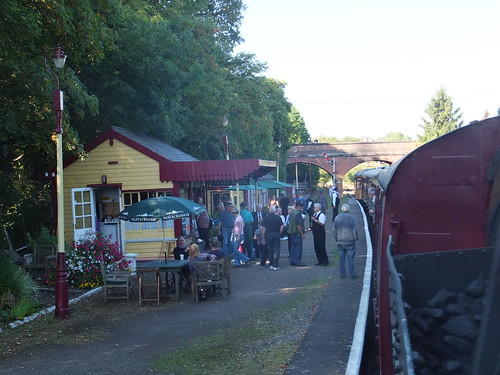 '3803' pauses at Market Bosworth.
'3803' pauses at Market Bosworth.
The day passed pleasantly and we were able to keep close to 'right time'. However, on the last return from Shenton, we were advised that a lineside fire had been spotted near Headley's Crossing. When the crossing came in sight, we could see smoke rising near the right side of the line. Once grass is dry, even a small spark from the chimney or a small piece of coal dropping from the ashpan can ignite a fire. If you're lucky, it will burn itself out once the grass is consumed but, otherwise, timber in the vicinity may create the risk of a serious conflagration. We stopped level with a small area of flame. A dousing with the Coal Watering Pipe soon made that safe and with Steve using a Fire Beater carried on the engine for the purpose and me wielding a firing shovel, we made sure the area was safe. Wooden railway sleepers, having usually been treated with creosote or similar chemicals to prevent rotting, can be quite difficult to extinguish once alight. Once we were satisfied that all was well, we clambered back on the engine, waited for a 'Right Away' from the Guard and finished our trip, only a few minutes late.
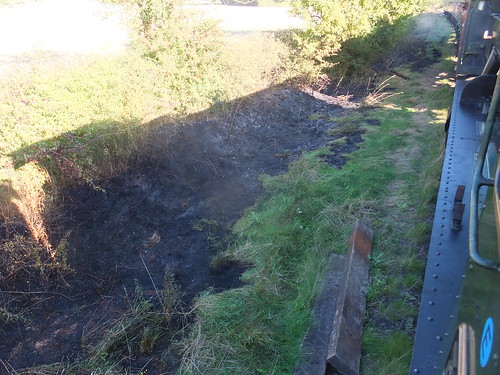 On the last trip, we stopped near Headley's Crossing to ensure a lineside fire was out.
On the last trip, we stopped near Headley's Crossing to ensure a lineside fire was out.
It only remained to shunt to the shed and dispose before 'signing off'. Steve and I agreed that we'd had a good day.
Other posts featuring '3803' in this blog
Another Busy Week.
Santa at Shackerstone.
A Day on the Footplate (1).
Battlefield Line Santa Specials 2011.
Summer Saturday with a '2884'.
My pictures
Shackerstone Family Festival 2014
This article is only a brief introduction to an important and complex topic.
Methods of operation
Turnouts or 'points' on a railway may be locally operated ('Hand points') or remotely operated from a Ground Frame or a Lever Frame in a signal box, as illustrated in the pictures below.
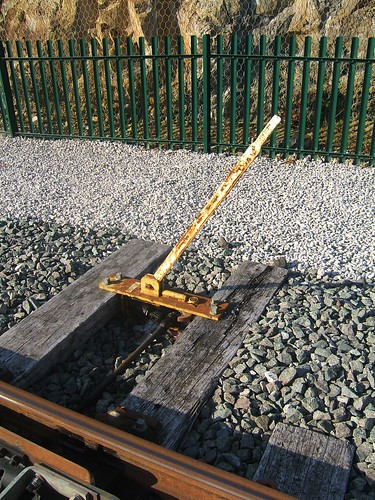
Point lever for Hand Points at Matlock Town on Peak Rail.
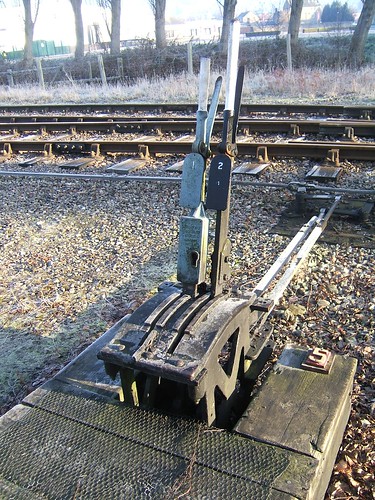
2-lever Ground Frame released by Single Line Staff at Darley Dale
South Yard on Peak Rail.
 Midland Railway pattern lever frame at Matlock Riverside
Midland Railway pattern lever frame at Matlock Riverside
signal box on Peak Rail.
Methods of Remote Operation
In the U.K., remote operation was initially achieved by transmitting a force mechanically and this method is still used today. Overseas, a 2-wire system was developed using flexible steel cables but this is outside the scope of this article, as are the more modern methods of operation using electro-pneumatic, electro-hydraulic or electric motor techniques.
Remote, Manual Operation
The signalman's effort is transmitted mechanically via a system of point rodding made of steel tube or steel inverted 'U' channel. This rigid tubing or 'U' channel allowed both a 'pull' (to change the points) or a 'push' (to restore the points to the original position) to be transmitted.
 'U' channel point rodding supported on an Anti-Friction Roller Frame, mounted on pre-cast concrete base.
'U' channel point rodding supported on an Anti-Friction Roller Frame, mounted on pre-cast concrete base.
Where changes of direction are required, Bell Cranks are installed.

Bell Cranks introducing a 90-degree change of direction.
At the point where the rodding is attached to the switch rails of the points, an adjustable crank is usually provided, allowing the correct 'throw' to be set.
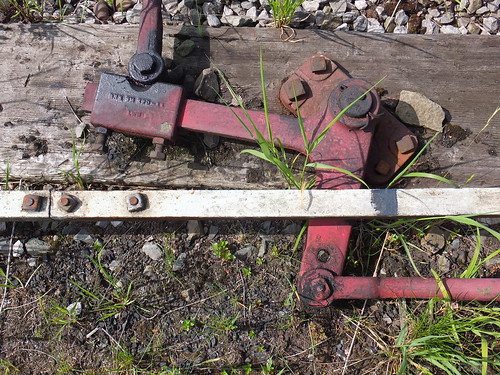 Adjustable Crank.
Adjustable Crank.
A 'Compensator' ('Comp') is placed at the centre of each run of point rodding, which reverses a 'pull' into a 'push' but prevents temperature changes from moving the point blades because the expansion in the two lengths of rodding cancel out.
 Point Compensator.
Point Compensator.
'Facing' and 'Trailing' points
Turnouts may be 'Facing' (where, in the direction of travel, one line divides into two) or 'Trailing' (where, in the direction of travel, two lines combine into one).
Ensuring Facing points are 'fitting-up' correctly
Facing turnouts are more dangerous because of the risk of derailing a train if the points are not 'fitting-up' accurately when a train passes over them. To ensure that switch rails are 'fitting-up', facing points on passenger lines are equipped with a Lock Stretcher joining the 'toe' of the two switch rails. The Lock Stretcher is provided with two notches so that the points may be bolted in the normal or reverse position by driving a rodding-operated Facing Point Lock (FPL) through the appropriate notch. The picture below shows a typical facing turnout on the Battlefield Line (this example constructed using 'Bullhead' rail). There are two runs of point rodding (of inverted 'U' section) connected back to the controlling signal box. One set of rodding actually operates the FPL. When the FPL is driven into a notch, the points are held firmly in position. The FPL must be drawn back clear of the notch by the rodding before the actual points can be moved using the other set of point rodding.
 Facing Turnout at Market Bosworth on the Battlefield Line (currently 'clipped out of use').
Facing Turnout at Market Bosworth on the Battlefield Line (currently 'clipped out of use').
The following picture shows the Facing Points on the Down line at Darley Dale (also constructed using 'Bullhead' rail). The Adjustable Crank in the foreground drives the Facing Point Lock into one of two notches in the Lock Stretcher of the points, according to whether the points are Normal or Reverse. This Adjustable Crank is operated from the signal box via the rodding run nearer the track. The rodding run away from the track drives the switch rails through a second Adjustable Crank (partly hidden behind the electrical detection box).
 Facing Turnout at Darley Dale on Peak Rail.
Facing Turnout at Darley Dale on Peak Rail.
The picture below shows more constructional details. To make sure the stock (outer) rails don't move, the slide chairs at the 'toe' fix through a metal soleplate, which has an insulator (right of the FPL) to avoid shorting electric track circuits, where provided. The switch rails are joined by an insulated Lock Stretcher, provided with two notches. The cover over the Facing Point lock has been removed in this picture to show how the 'joggle' in the FPL is used to drive the FPL detector rod left and right, indicating whether the FPL is engaged in a notch or not.
 Closer view of Facing Turnout at Darley Dale on Peak Rail.
Closer view of Facing Turnout at Darley Dale on Peak Rail.
The picture below shows a pair of Signal Detectors (one for each route) fitted in the signal wires leading from the signal box to signals reading through the points. The metal detector blades connected to the adjacent points are notched so as to prevent a signal being cleared unless the correct closed switch rail is fitting up properly and (usually) that the points are 'bolted' by the FPL.
 Signal Detectors at Shackerstone on the Battlefield Line.
Signal Detectors at Shackerstone on the Battlefield Line.
A more modern alternative to providing Signal Detectors is to fit Electrical Detection (ED). This is an electrical contact box where a circuit is closed only when the correct closed switch rail is fitting up and the points are 'bolted' by the FPL. The picture above of a Facing Turnout at Darley Dale shows the moulded cover of the electric contact box. In the signal box, electric locks are provided on the signal levers so that the signal can only be cleared when the Electric Detection at the points confirms that the points are correctly set.
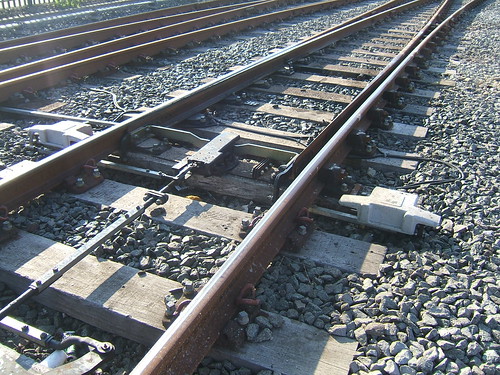 Facing turnout ('Flatbottom' rail) with Facing Point Lock and Electrical Detection at Matlock Town.
Facing turnout ('Flatbottom' rail) with Facing Point Lock and Electrical Detection at Matlock Town.
Ensuring Facing points are not moved prematurely
There is also a risk of derailing a train on facing points if the signalman is allowed to attempt to move the points whilst a train is passing. If a signal has been cleared for a train to pass over Facing points, the FPL must be correctly bolting the points. Before the signalman can attempt to move the points, the signalman must first replace the signal to danger and then operate the lever to withdraw the FPL.
There is an informal design rule, sometimes called Murphy's Law (or, in England Sod's Law) which states that "If a thing can go wrong, it will go wrong". It became clear that facing points required a safeguard to prevent attempted premature movement. This was provided by arranging a flat-topped Locking Bar just inside one rail on the approach to facing points, supported on a series of moveable short Rockers fixed to the web of the rail. The Rockers normally lay at about the "10 o'clock" or "2 o'clock" position so that the top of the Locking Bar was below the level of the wheel flanges. The rodding which pulled and pushed the FPL was also arranged to pull and push the Locking Bar, turning the Rockers so that, at the "12 o'clock" position, the whole locking bar was lifted up. With the FPL either in or out, the Rockers sat at about "10 o'clock" or"2 o'clock", with the Locking Bar below the level of the wheel flanges.
If a train was standing or passing over the Locking Bar when the signalman attempted to withdraw the FPL, the Locking Bar would lift as the Rockers turned and the wheel flanges would interfere with the raising of the Locking Bar and prevent the FPL from being withdrawn. The Locking Bar had to be longer than the maximum distance between wheelsets on a train, otherwise there was a risk of the points being moved between one wheelset and the next. The longest bogie coach in use normally determined how long the locking bar needed to be. Having changed the points safely, the signalman could then operate the FPL to bolt them, at the same time lifting the locking bar until the rockers had passed the "12 o'clock' position
This was an effective mechanical technique but it could be cumbersome to implement and maintain. It could also be tiring for the signalman. Years ago, I unofficially worked a number of signalboxes including Deepfields which had four facing points provided with Facing Point Locks and co-acting Locking Bars and even that was challenging.
Much later, Track Circuits were used to detect the presence of a train in the danger zone, allowing Locking Bars to be eliminated although Facing Point Locks are still used. I've included below a couple of pictures I took in Myanmar where Locking Bars are still used in a few places. In the first picture, the FPL rodding works a crank fitted between the rails. To this crank a drive rod to the Facing Point Lock is fitted. Two more drive rods connect to the Locking Bar set inside the left hand rail to pull and push the Locking Bar as the Facing Point Lock is moved.
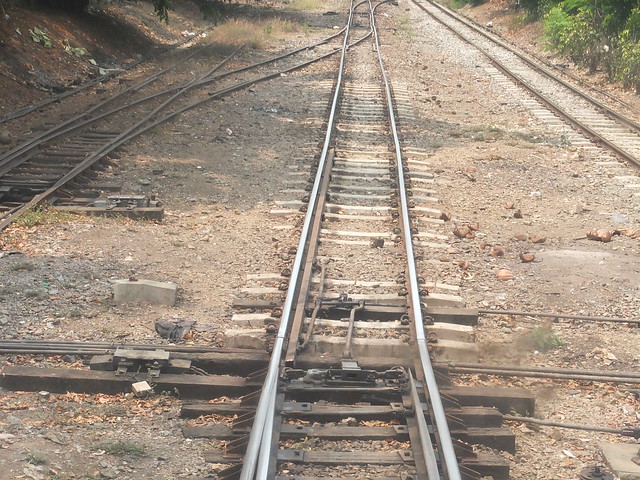 Detail of Facing Point Lock and Locking Bar at the north end of Kyee Myin Daing station in Myanmar.
Detail of Facing Point Lock and Locking Bar at the north end of Kyee Myin Daing station in Myanmar.
The picture below shows two sets of points, both arranged with Locking Bars. The Locking Bar inside the left hand rail works in connection with the turnout in the foreground. The Locking Bar inside the right hand rail protects the turnout in the background.
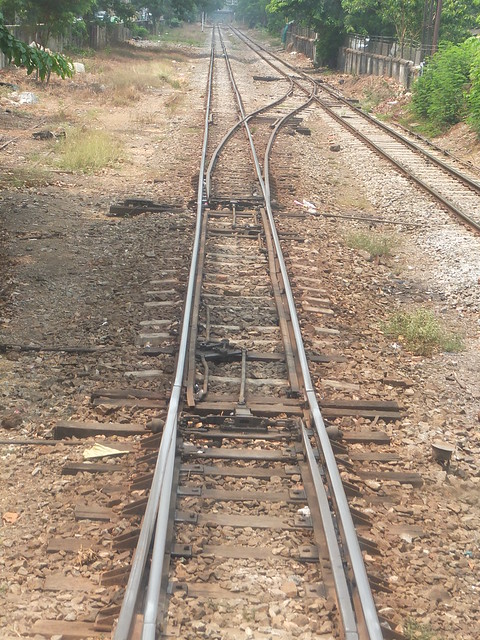
Detail of Facing Point Locks and Locking Bars at the north end of Kyee Myin Daing station in Myanmar.
Finally, the picture below shows the famous Blackpool Tower and a delightful Lancashire and Yorkshire Railway 5-arm shunting signal in 1921 with, bottom left, the tangle of Locking Bars and rodding necessary in congested areas. In this case, locking bars are fitted along the switch rails themselves. It is easy to see that maintenance of this vital safety equipment would be difficult.
 Approach to Blackpool Central Station in 1921 (Photo: N.R.M.)
Approach to Blackpool Central Station in 1921 (Photo: N.R.M.)
"Avast, me hearties!"
The 19th of September is 'International Talk Like a Pirate Day'. You didn't know? I've only just found out. The official website is here.
"Look lively, ye bilgerats!"
There's background on Wikipedia here.
"Aaaarrrr, Matey"
The useful site 'timeanddate.com' has a feature on the event here.
"Aaaarrrr, Jim lad, there be Treasure Island!"
The "patron saint" of International Talk Like a Pirate Day is the English actor Robert Newton, for his creation of the one-legged, swivel-eyed pirate Long John Silver in the 1950 Walt Disney film Treasure Island.
"Shape yerselves, ye loathsome landlubbers!"
It appears that exposure to the film years ago had more of an effect than I realised. Apparently, one of my comedy heroes Tony Hancock regarded Robert Newton as a 'role model' and was certainly known to effect the 'pirate voice' on occasion.
"Pieces of Eight, Pieces of Eight"
"That's me parrot yer scabby idiot, not me: I'll see ye walk the plank for that"
On Monday, 8th September 2014 I attended a business meeting in London. I decided to catch the 06:27 Virgin service from Wolverhampton, due into Euston at 08:15, which would give me a couple of hours spare before going to my meeting. This allowed me to have a look at the Liverpool Street terminus of the former Great Eastern Railway. I'd rarely visited Liverpool Street so I wanted to take a few pictures. My train reached Euston on time and I decided to walk to Euston Square underground station and take the Metropolitan Line (also carrying the Circle Line and Hammersmith & City Line trains at this point) five stops east to Liverpool Street.
By London Underground
The familiar old 'Met Line' 'A' stock has been replaced by the new Bombardier 'S' stock, described in a Wikipedia article here. When deliveries are complete, 191 trains will have been supplied for the Metropolitan, Circle, Hammersmith & City and District Lines, provided with air conditioning and capable of running from 750 volts d.c. when the power supply is upgraded. The introduction of this fleet has not been without a fair amount of grief. The picture below is actually the first 'S' stock train I saw, back in April 2011.

Bombardier 'S' stock.
Perhaps even now all the problems have not been eliminated: my 'S' stock train started away from Euston Square and, after a few yards, made a sudden stop. After a short pause, we set off again and there were no further oddities, although I did find the Mitsubishi air conditioning noisy.
Liverpool Street Station
On arrival at Liverpool Street, I made my way via the escalators to the concourse of the main-line station. This is light and airy beneath a complex glazed roof supported on cast iron columns. The mezzanine floor with its range of retail units in a curious modern style was less appealing.
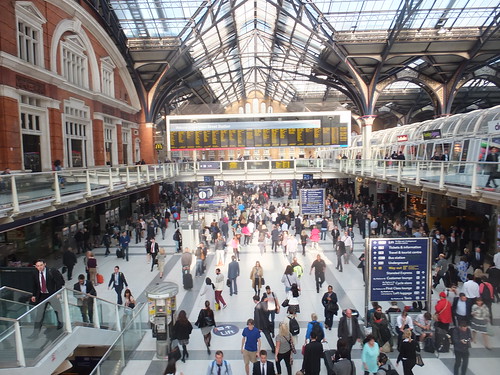 The concourse at Liverpool Street station.
The concourse at Liverpool Street station.
There have been so many rebuildings of the station that the present result is something of a pastiche, with many of the original features moved or modified. For example, the large War Memorial for World War I has been relocated and the lower left panel now features a set of lift doors.
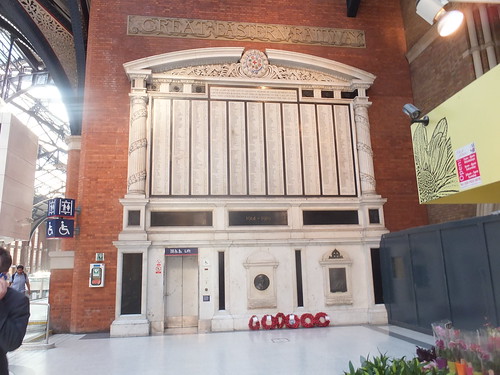 WWI War Memorial, complete with lift doors.
WWI War Memorial, complete with lift doors.
Liverpool Street Background
The station was first opened in 1874 to replace the earlier Bishopgate station (which became a goods depot). In 1890, work started to add a further 8 platforms on the eastern side of the station. The station suffered serious bomb damage during World War I but by the 1920s, an intensive suburban steam service (commonly called 'The Jazz') was carrying unprecedented numbers of commuters. In the 1930s, the electrification of the line to Shenfield was planned but implementation was delayed by World War II (when the station suffered bomb damage again). In 1949 the Shenfield line was electrified and, by 1960, the line to Chingford had also been electrified. The Broadgate Development, authorised in 1985, brought further major change. Broad Street Station (immediately to the west of Liverpool Street Station) was abolished and the area used for the development of commercial property. New connections allowed trains which had previously served Broad Street Station to be diverted to Liverpool Street Station. Further commercial building was authorised on the east side of Liverpool Street Station. A reconstruction of the station took place and, as part of the resignalling, Liverpool Street received the first Integrated Electronic Control Centre (IECC) in Britain. Queen Elizabeth II officially opened the redeveloped station in 1991. In 1993, the notorious Bishopgate Bombing caused further damage to the station. For more information on Liverpool Street, see the Wikipedia article here.
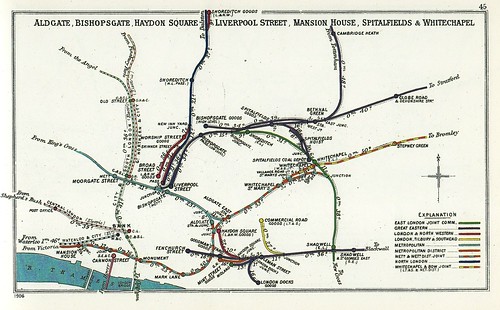 Click here for larger image
Click here for larger image
Lines around Liverpool Street in 1906.
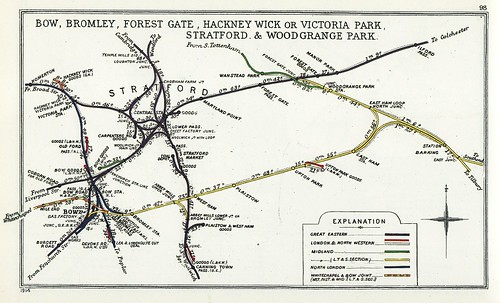 Click here for larger image
Click here for larger image
Lines around Stratford in 1914.
Keith Jaggers has an interesting 1993 article about Liverpool Street here.
Travelling from Liverpool Street
In 2011 I'd travelled from Liverpool Street to Chelmsford for 'Lionsmeet 2011', described here.
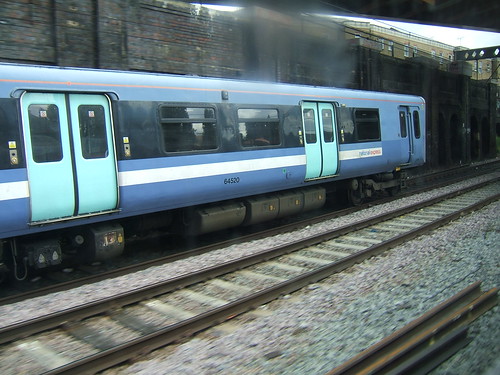 A 'national express' Class 313 service leaving Liverpool Street on the Down Suburban in 2011.
A 'national express' Class 313 service leaving Liverpool Street on the Down Suburban in 2011.
This time, I'd decided to travel as far as Stratford, so I made my way to a Southend service, a 12-car Class 321 in 'abellio greater anglia' livery. It appears that all these Train Operating Companies have a phobia concerning capital letters.
 The Class 321 for Southend stands in Liverpool Street.
The Class 321 for Southend stands in Liverpool Street.
Leaving Liverpool Street, there are six running roads. From the west, the Down Suburban and Up Suburban pass through Bishopgate Tunnel, the Down Main and Up Main pass through a cutting, as do the Down Electric and Up Electric (despite the name, all six lines now have overhead electrification). Then we made the 1 in 70 climb to Bethnal Green, just over a mile from the start, where only the Suburban Lines have platforms before they sweep away to the left towards Hackney Downs, accompanied by two lines branched from the Main lines. Another mile and a half takes us to Bow Junction where a single line connection from the Fenchurch Street Lines joins on our right, together with the single line Docklands Light Railway from Poplar. On our left, the Down and Up Temple Mills diverge from the Main and run parallel while beyond lies the Olympic Park.
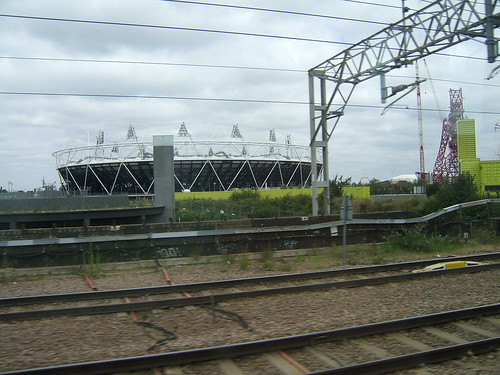 The Olympic Park under construction in 2011. L: Olympic Stadium R: ArcelorMittal Tower.
The Olympic Park under construction in 2011. L: Olympic Stadium R: ArcelorMittal Tower.
The budget for the Olympic Stadium in the original bid was 300 million pounds. It actually cost 429 million pounds. It's currently being converted as a new home for West Ham Football Club. This was supposed to cost 154 million pounds but, at the time of writing, there's a wrangle over problems with the roof estimated at 15 million pounds. The ArcelorMittal Orbit (as it's now called with its strange capitalisation within a word) was commissioned as a piece of "Public Art". Huh? The picture below shows the same location in 2014.
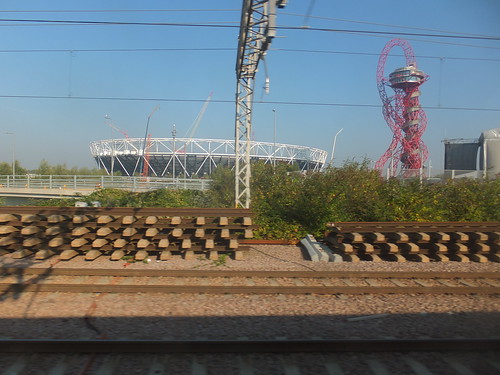 The same location in 2014. L: West Ham stadium under conversion R: ArcelorMittal Orbit.
The same location in 2014. L: West Ham stadium under conversion R: ArcelorMittal Orbit.
Just before Stratford station, Carpenters Road Curve and Channelsea Curve form a triangular junction on our left. I alighted at Stratford and took a few pictures around the station. To the south east, the Central Line trains still pop out of the ground, pause briefly, then dive underground again. A single bay platform terminates the Docklands Light Railway branch from Poplar. To the north west, the Down and Up Temple Mills diverge to the left and, beyond, a fairly modern island platform terminates the Overground services. Beyond that, the Westfield Stratford City looms over everything. It's a big shopping centre with 336 'stores'. Whatever happened to 'shops'?
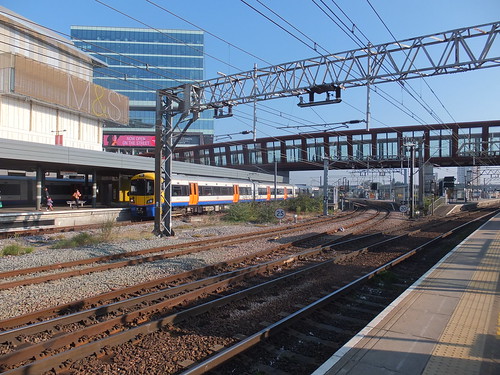 View of Stratford Station from platform 9. L to R: Westfield Stratford City, Overground platforms, Down & Up Temple Mills platforms, Southend lines.
View of Stratford Station from platform 9. L to R: Westfield Stratford City, Overground platforms, Down & Up Temple Mills platforms, Southend lines.
I left the station and walked north along Montfichet Road, skirting the towering walls of the Westfield Stratford City to reach the bridge over the High Speed One extension into St. Pancras.
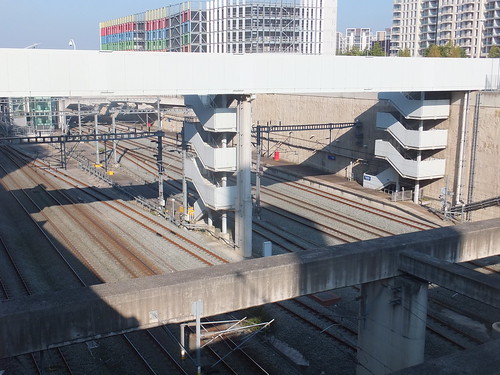 Trackwork at the east end of Stratford International.
Trackwork at the east end of Stratford International.
I returned to Stratford Station and decided that my best route to Victoria for my meeting would be Central Line to Oxford Circus and then Victoria Line two stops to Victoria. So that's what I did.
Books
[1] 'The Great Eastern Railway' by C. J. Allen published by Ian Allen (ISBN: 07110 0659 8).
[2] 'Great Eastern Album' by R. C. Riley published by Ian Allen (ISBN: 7110 0063 8).
[3] 'London's Termini' by A. A. Jackson published by Pan Books Ltd (ISBN: 0 330 02747 6).
Maps
'Railway Track Diagrams Book 2: Eastern' published by TRACKmaps (ISBN 0-9549866-2-8).
My pictures
London: Former Great Eastern Line.
Channel Tunnel and High Speed One.
London.
The Bradford Model Engineering Society was constituted in 1908 and claims to be the fourth oldest model engineering society in the world! Their website is here. On Saturday, 23rd August 2014, the Society hosted the 2014 'Lionsmeet' at their picturesque site in Northcliffe Woods, Shipley. 'Lionsmeet' is the annual get-together of live steam models of the 'Lion' locomotive organised by the Old Locomotive Committee (usually referred to as 'OLCO'). The OLCO website is here. Having been associated with OLCO myself for more than 25 years, my own blog has quite a few posts. You can find all my posts about 'Lion' - both the full-size version and live-steam models here.
Until 2013 (when 'Lionsmeet was held at the Wirral Model Engineering Society track at Royden Park) 'Lionsmeet' had always included a not-too-serious competition to see which model could produce the greatest 'work done' in ten minutes. As an experiment, the competition was omitted in 2013 and, following a fairly favourable response, the competition was also omitted from the 2014 event.
I travelled by train to Shipley (as described in the post Day Trip to Shipley) and then walked to Northcliffe Woods where a plaque on the main gate records their opening on 12th June 1920, the gift of Sir H Norman Rae MP, as an open space for recreation and benefit of the public, forever. The Friends of Northcliffe are a local community group involved in managing the area.
A pleasant walk through the woods led me to my destination. Uniquely, the Clubhouse is a converted Bandstand! The flat area in front of the building, originally for the audience, now boasts a raised oval track around 440 feet long with dual-gauge 3½" and 5". This track was relocated by the society from its previous home and, unusually, the dual-gauge track is 4-rail rather than the more common 3-rail.
 The Clubhouse. Far left, John Mills steps over the raised track.
The Clubhouse. Far left, John Mills steps over the raised track.
I was not surprised that David Neish was the first driver out onto the track, with his extremely reliable 'Lion'. Later, his son Andrew (who had organised the event) took over the engine.
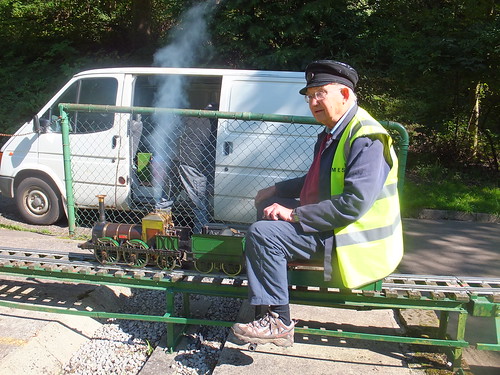 Lionsmeet 2014: David Neish with his 'Lion'.
Lionsmeet 2014: David Neish with his 'Lion'.
A turntable is positioned in the raised track, giving access to three steaming bays. The picture below shows the turntable, the passenger loading and unloading area beyond (used when giving public rides) and the short tunnel. In the foreground, the four aluminium rail construction of the dual-gauge track can be seen.
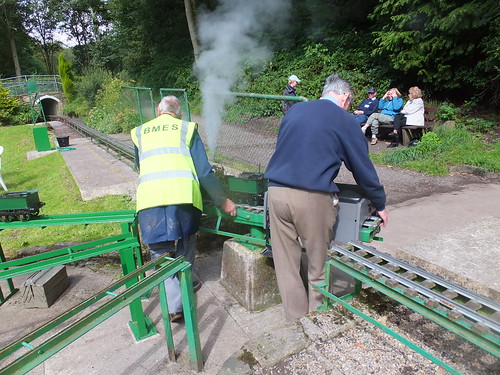 The turntable on the raised track.
The turntable on the raised track.
Later a number of drivers, including Jon Swindlehurst, David Wainwright and a local 'Lion' sporting a very nice 'Lowmac' well wagon as a driving trailer put their 'Lion' models through their paces.
 John Mills and Jon Swindlehurst
John Mills and Jon Swindlehurst
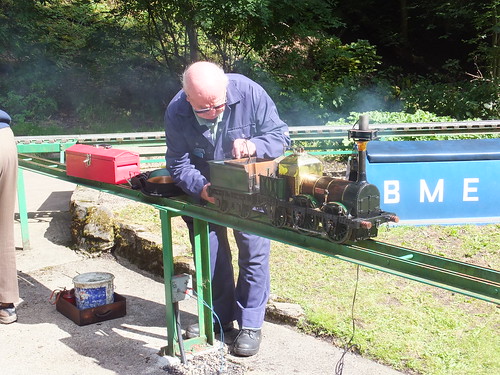 David Wainwright prepares his 'Lion'.
David Wainwright prepares his 'Lion'.
Alan Bibby was particularly unfortunate - he waited until his grandsons arrived so that they could assist in preparation and receive some driving tuition but, by this time, it had started to rain quite heavily. To add insult to injury, having given the crew a good soaking, the rain stopped and the sun came out again. Only a few weeks previously I'd experienced something similar when driving at the Battlefield Line on the 19th July (described in the post Another Busy Week). Once again, I was reminded of my saying: "Anyone can work on the footplate in good weather. It takes an engineman to do it in bad weather".
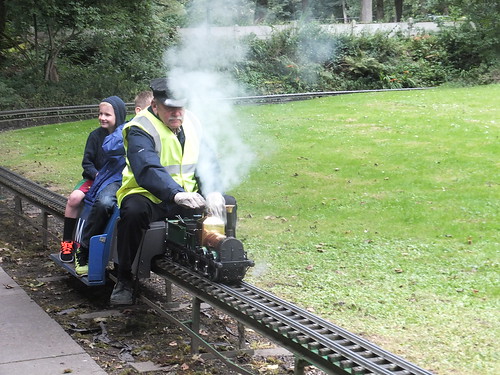 Alan Bibby, before the worst of the rain.
Alan Bibby, before the worst of the rain.
The host Club made us very welcome throughout the day with beverages, a morning bacon bap and, later, lunch. With the drivers mentioned above, the Chairman of OLCO, John Brandrick, Magazine Editor John Hawley and OLCO member Keith Taylor-Nobbs present, there was plenty of earnest discussion. Jon Swindlehurst's 7.25-in 0-4-2 locomotive under construction was much admired but some were perplexed by his decision to fit Stephenson Link Motion!
An early live-steam model of 'Lion' stirred considerable interest - the maker's plate is marked 'Worthing Works 1953'. The owner hopes that it will be in steam again next year.
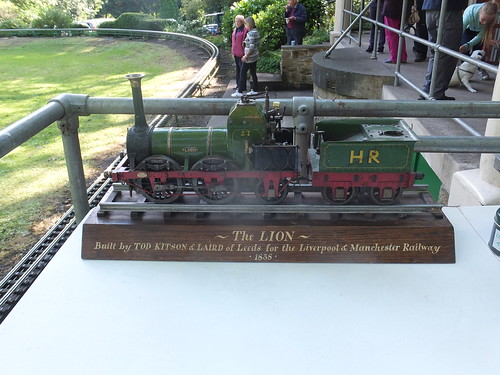 An early live-steam model of 'Lion'.
An early live-steam model of 'Lion'.
The Chairman of OLCO, John Brandrick decided that Keith Taylor-Nobbs should be the first recipient of the Charles Taylor-Nobbs Memorial Trophy, for his splendid 'Lion' model which was on display.
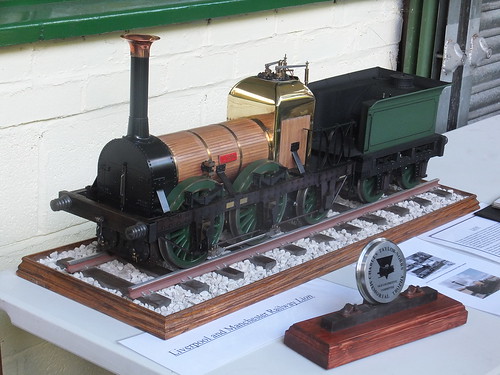 Keith Taylor-Nobbs museum-quality 'Lion' model was, appropriately, the first recipient of the Charles Taylor-Nobbs Memorial Trophy.
Keith Taylor-Nobbs museum-quality 'Lion' model was, appropriately, the first recipient of the Charles Taylor-Nobbs Memorial Trophy.
More recent developments at Bradford Model Engineering Society have centred on the construction of a ground level dual-gauge 5" and 7.25" track with a circuit of around 2,000 feet with a station area, turntable with steaming bays, carriage 'shed' (actually large concrete pipes) and a siding leading to the Store Room at the rear of the Clubhouse. The layout features dual-gauge points and diamond crossings.
 Dual-gauge Diamond Crossings on the ground level track.
Dual-gauge Diamond Crossings on the ground level track.
Seeing my interest, I was offered a ride around the track behind the Club's Petrol-Hydraulic locomotive (using a Honda engine). When we arrived at the station, which has three lines passing through it, I was shown the very professional signalling control panel. A small compressor is mounted below the control panel, providing air for the pneumatic operation of the main points. Very rugged colour light signals are provided where required.
 Control panel for points/signals at the station on the ground level track.
Control panel for points/signals at the station on the ground level track.
Before people started to leave, John Brandrick gave a vote of thanks to Bradford Model Engineering Society for their hospitality - it had been a good event.
 This rather nice Austin motor car was parked adjacent to the raised track for most of the day.
This rather nice Austin motor car was parked adjacent to the raised track for most of the day.
My pictures
Lionsmeet 2014.
On Saturday, 23rd August 2014 I made a day trip by train from Wolverhampton to Shipley (near Leeds in Yorkshire) to attend the 2014 'Lionsmeet' event organised by the Old Locomotive Committee (where I currently serve as Secretary). There's a report on 'Lionsmeet 2014' here.
In the past, I've sometimes travelled to Leeds via Birmingham and Derby but I'd decided to travel via Manchester to Leeds, allowing me to stop off at Huddersfield for photographs. In fact, the National Rail Journey Planner recommended the route via Manchester in any case.
The Outward Journey
I started from Wolverhampton at 06:49, catching the Arriva Cross Country 'Voyager' which runs via the former LNWR route to Norton Bridge (north of Stafford) then over the former North Stafford Railway route via Stone, Stoke-on-Trent and Macclesfield, rejoining the LNWR Crewe to Manchester line at Cheadle Hulme (just south of Stockport). It irks me that the diesel-electric 'Voyagers' run 'under the wires' to Manchester because their route south of Birmingham to Bristol and the West Country is not electrified.
We arrived at Manchester Piccadilly (formerly Manchester London Road) on time at 07:59, giving me adequate time to cross the station to through platform 13 for the 08:10 First TransPennine Express service for Leeds and beyond, operated by a 3-coach Class 185 'Desiro' multiple unit built by Siemens. The train was already well-loaded and with a large number of reserved seats but at least I found a seat (an improvement on previous trips where I've often had to remain standing).
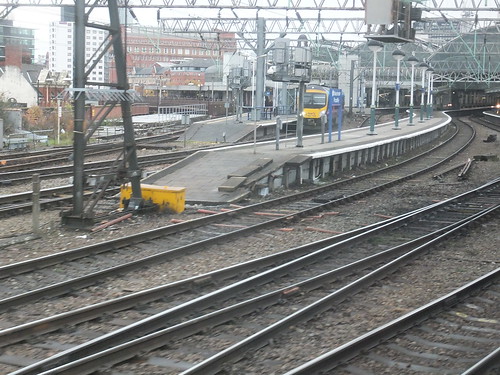 A First TransPennine Express in platform 13 at Manchester Piccadilly in 2013.
A First TransPennine Express in platform 13 at Manchester Piccadilly in 2013.
We picked up a lot more passengers at Stalybridge and then continued on the hilly route into Yorkshire, taking the double track Stalybridge Old Tunnel through Mossley and Greenfield to Diggle. This was an important passenger and freight route for the Lancashire and Yorkshire Railway and from Stalybridge there had been a separate double-track line through Micklehurst, now abandoned, which rejoined the Mossley line at Diggle from where the line continued as four-track to Thornhill. Today, the route is double track although the evidence of the abandoned lines can be seen. Beyond Diggle, we passed through through the 3-mile long double-track Standedge Tunnel. There remain the two abandoned single line tunnels which carried the slow lines before the competition from road transport took away most of the freight traffic. From Manchester, the line climbs continuously to Standedge Tunnel which is level and is the summit of the line. Emerging from the tunnel, it's then downhill right through Huddersfield to Thornhill. There's some information on the route from Stalybridge to Heaton Lodge on the 'Lost Railways West Yorkshire' site here.
Huddersfield Interlude
I alighted at Huddersfield just before 08:45 because I wanted to take some pictures of the remarkable station buildings, which incorporates a range of massive stone buildings with the appearance of a major country seat in Classical style. The famous Doric Arch at Euston station is long gone (in an earlier post on London's Terminal Stations I refer to its demolition as "an act of gross vandalism which will never be forgiven") but Huddersfield retains its magnificent station.
There's a description of the Grade 1 buildings at Huddersfield in "Architect Speak" on the British Listed Buildings Site here. The two-storey central building has six massive columns at the front flanked by colonnades terminated in single-storey lodges on either side.
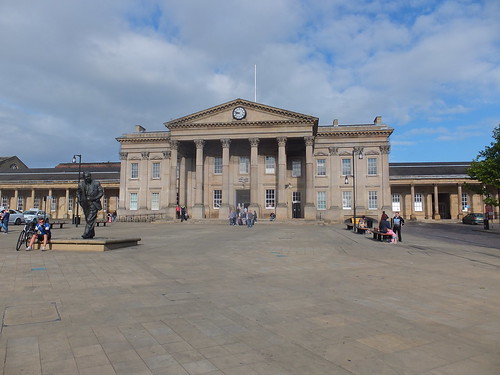 Huddersfield Station.
Huddersfield Station.
The lodge on the left is now the railway-themed 'Head of Steam' public house. The stone pediment carries the carved arms of the Lancashire and Yorkshire Railway, painted in the correct colours.
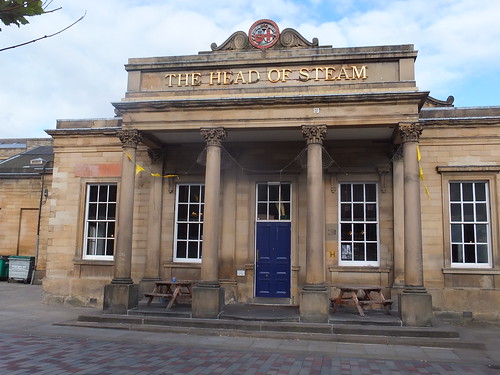 The 'Head of Steam'.
The 'Head of Steam'.
The lodge on the right is currently receiving attention from builders. This lodge is also now a public house called the 'King's Head'. The stone pediment carries the carved and coloured arms of the Huddersfield & Manchester Railway & Canal Company, in need of some restoration.
 The arms of the Huddersfield & Manchester Railway & Canal Company above the 'King's Head'.
The arms of the Huddersfield & Manchester Railway & Canal Company above the 'King's Head'.
Just across the adjacent car park there's a somewhat more utilitarian building carrying a water tank, which has been brought into community use by the Association of Community Rail Partnerships (ACoRP). There's a detailed account of the project to convert the Grade 1 listed Huddersfield Water Tower here.
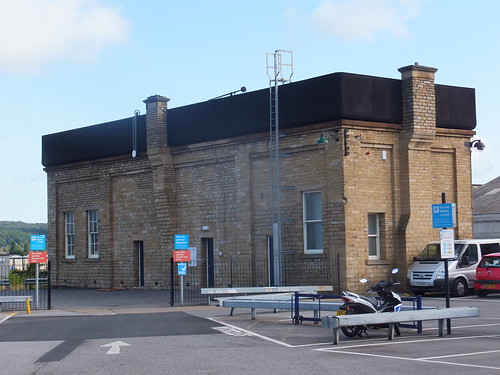 Huddersfield Water Tower
Huddersfield Water Tower
Huddersfield station also has a large brick goods warehouse incorporating a wagon hoist, apparently disused. There's a collection of pictures here. The building has carried a PDR CONSTRUCTION sign for some years. A very brief entry on their website posted on 12th January 2013 by T. Weber refers rather enigmatically to "£15M Private Investment to Transform Warehouse Into Commercial Units In Huddersfield" so I suppose they're waiting for somebody to offer the finance.
 Huddersfield Goods Warehouse.
Huddersfield Goods Warehouse.
The Journey Resumed
Because of time constraints, I couldn't see much of the town on this trip. I boarded a heavily-loaded Leeds train which lost no time heading for Heaton Lodge Junction where we merged with the Calder Valley Line from Preston and Blackburn. Through Mirfield, there's still a 'third line' designated Up Slow. Mirfield was the site of the unique British Speed Signalling installation described on 'The Signal Box' site here. This was put in by the Chief Signal & Telegraph Engineer of the L.M.S. A. F. Bound in 1932 and lasted until 1970. At Thornhill Junction, we took the Dewsbury line and started climbing again to Morley Tunnel (nearly 2 miles long), emerging on a downhill section which would last the final four miles to Leeds.
We ducked under the electrified line from Doncaster to approach Whitehall Road Junction where there are six running roads. From the north, A and B are the Harrogate lines, C and D are the Doncaster/Shipley lines and E (our line) and F are the Huddersfield lines. Although the six roads normally operate as three sets of double track, they are all bi-directional when required. Control is from York Integrated Electronic Control Centre (IECC). We entered the station on the Through Road and, halfway through the station, took the crossover to stop in platform 12c. The through platforms numbered 7 to 16 (there's also now a bay platform 17) formed Leeds New Station which was shared by the LNWR and the North Eastern Railway.
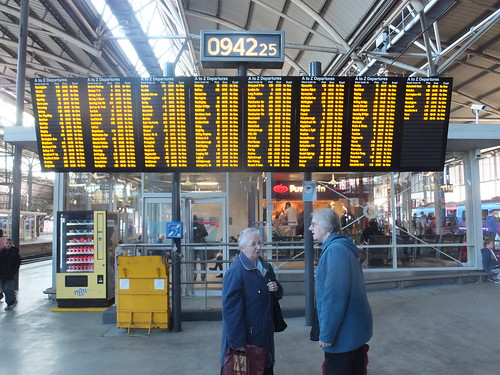 Leeds: A fairly daunting Passenger Information Display on platform 12/15.
Leeds: A fairly daunting Passenger Information Display on platform 12/15.
I identified the next Shipley departure and scuttled across the footbridge to reach the terminal platforms numbered 1 to 6 (which originally formed the Midland Railway's separate Leeds Wellington Street Station. Beyond the Midland station was a further terminus, Leeds Central, which was originally joint LNWR, Lancashire & Yorkshire Railway, Great Northern Railway and North Eastern Railway. Once Leeds New Station opened, the importance of Leeds Central declined and it was finally closed in 1967). I'd been directed to a 2-car Class 158 for Carlisle which was about due to leave but the platform was still crowded with waiting passengers and the lady Guard who was unable to open the doors until the Driver climbed into the cab and started the engines. We were pretty full leaving Leeds but I secured as seat and we soon set off on the Down Harrogate, crossing to the Down Shipley at Armley Junction. It didn't take long to cover the 12 miles to Shipley, where the train stopped briefly in platform 2.
 Shipley platform 2, showing the Class 158 setting off for the Settle - Carlisle line.
Shipley platform 2, showing the Class 158 setting off for the Settle - Carlisle line.
Being a station on a triangle of lines, it's easy to be disoriented. I wanted the Station Road exit, so I asked a member of platform staff. He admitted he'd only just moved to Shipley and had no idea. He suggested I check with another member of platform staff who seemed equally foxed. "I think the exit is through a subway" I added, to which the response was a shaking of the head. I lifted my eyes and immediately spotted a sign saying "EXIT - SUBWAY" not ten yards from where we were both standing.
So I was able to walk to the 'Lionsmeet' event and spend a pleasant day with old friends and new friends. One of the club members was concerned at the thought of me walking back to the station and insisted on taking me by car. The next service to Leeds was from Bradford Forster Square (a little under 3 miles away) and I had a few minutes to look around. The original stone station buildings were attractive, later additions in places were not so good and the modern footbridge with lifts was, as usual, out of sympathy with the remainder. The Booking Hall, with its curved glazed screen, was quite appealing, despite the modern fixtures and fittings.
 Shipley Station: the Booking Hall.
Shipley Station: the Booking Hall.
The Return Journey
My train to Leeds arrived at Shipley on time - an almost empty Class 333. It was quiet, comfortable and fast.
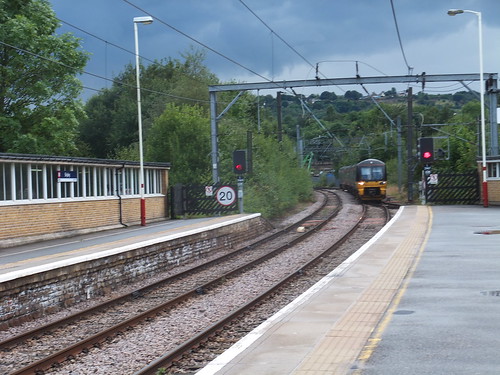 The Class 333 approaching Shipley platform 3 which returned me to Leeds.
The Class 333 approaching Shipley platform 3 which returned me to Leeds.
I finally managed a picture from the train of the two towers adjacent to the station, without the usual "knitting" of the overhead catenary. Only later did I discover they are the Verona Tower of 1864 (actually the boiler house chimney) and the Giotto Tower of 1899 (actually a dust extraction chimney), the remaining parts of the Tower Works of local industrialists the Harding Family. There's an interesting article on the 'Architecture Today' site here. The inspiration for the Leeds Verona Tower is the (much taller) Torre dei Lamberti in Verona, briefly described in Wikipedia here and the British Listed Buildings entry for this Grade II* structure is here. The inspiration for the Giotto Tower is the Giotto Campanile in Florence and is described in Wikipedia here and the British Listed Buildings entry for this Grade II* structure is here.
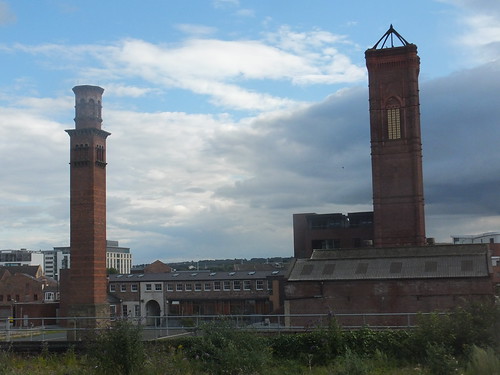 L: The Verona Tower, R: The Giotto Tower.
L: The Verona Tower, R: The Giotto Tower.
Back at Leeds, I made my way to the through platforms for the First TransPennine Express to Manchester Piccadilly. We set off with plenty of spare seats but, by the time we made our last pick-ups at Stalybridge, we were back to people standing. At Piccadilly, I caught the next Arriva Cross Country to the south-west via Wolverhampton.
My pictures
West Midland Railways.
Stoke Area Rail.
Manchester Area Rail.
Huddersfield Station.
Yorkshire's Railways.
Shipley Station.
 Adrian fitting the new firebars in the firebox, still hot from the previous day's steaming
Adrian fitting the new firebars in the firebox, still hot from the previous day's steaming
 Right hand driving wheel and big end of connecting rod.
Right hand driving wheel and big end of connecting rod.
 3803 ready to take the first departure from Shackerstone out of platform 1, with 'Blue Circle' in the background.
3803 ready to take the first departure from Shackerstone out of platform 1, with 'Blue Circle' in the background.
 '3803' ready to depart for Shenton as 'Blue Circle' resumes brake van rides.
'3803' ready to depart for Shenton as 'Blue Circle' resumes brake van rides.
 '3803' pauses at Market Bosworth.
'3803' pauses at Market Bosworth.
 On the last trip, we stopped near Headley's Crossing to ensure a lineside fire was out.
On the last trip, we stopped near Headley's Crossing to ensure a lineside fire was out.









































